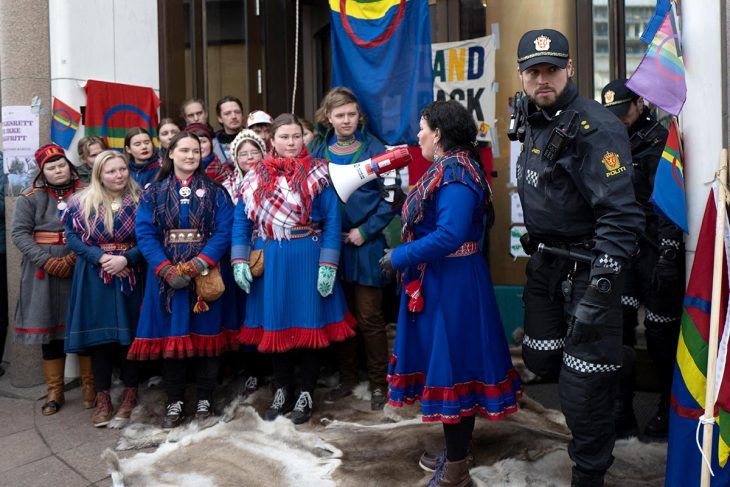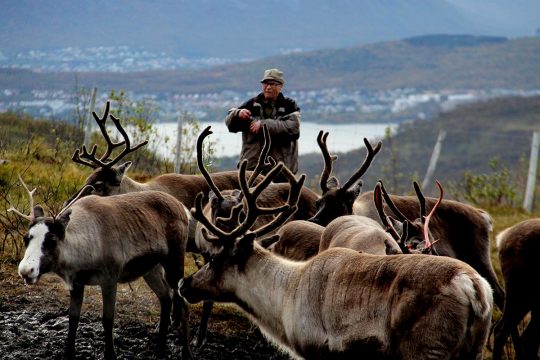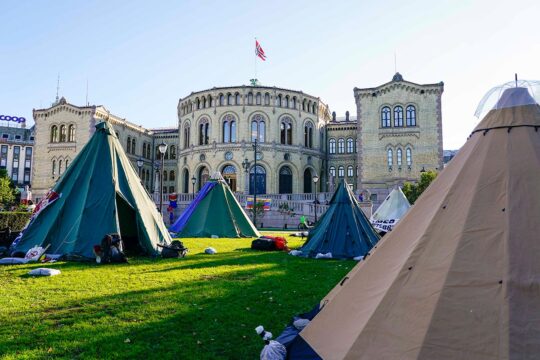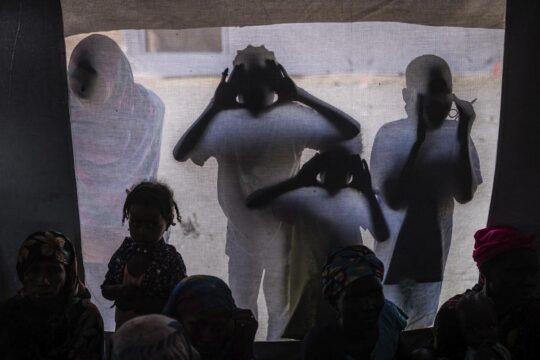On March 6th, the Norwegian Truth and Reconciliation Commission (TRC) conducted a larger hearing in the Norwegian Parliament with representatives of various parts of Indigenous peoples and national minorities, the Sami, Kven, Forest Finns and Norwegian Finns. The hearing coincides with intense protests that took place in Oslo last week, when Sami activists protested against outspoken inertia in the Norwegian state administration to act upon the verdict reached by the Norwegian Supreme Court in a case about a windfarms project in a Sami reindeer herding area. Sami activists called it a crisis of trust. A crisis which was also among the key concerns voiced in the TRC hearing.
The decision to establish a TRC on the assimilation policies conducted towards the Sami, Kvens and Norwegian Finns (Forest Finns were added to the list shortly after the commission took seat), was taken by the Norwegian Parliament in the Spring of 2018. The mandate states that the commission is obliged to document historical assimilation policies, to investigate the consequences of the assimilation up until the present day and to propose measures to contribute to further reconciliation.
In the past five years the commission has carried out archival research, collected witness accounts and conducted meetings with various parts of the affected communities around the country. The March 6 hearing was part of the finalization of the TRC Final Report, which will be handed over to the Norwegian Parliament on June 1.
Preserving languages and culture
35 institutions, organizations and associations representing various parts of the Sami, Kven, Forest Finn and Norwegian Finn communities had responded to the invitation to take part in the hearing. The session, which lasted 6 hours, gave each delegate 5 minutes to present a response of their own choice, with the option to also hand in a longer written statement. The entire 12-member commission was present and could ask clarifying questions.
Kvens, Norwegian Finns and Forest Finns were recognized as national minorities in Norway, when in 1998 the country ratified the 1995 European Council’s Framework Convention for the Protection of National Minorities. However, a Kven delegate spoke of the need that Norway recognizes the Kven as an indigenous people – alongside the Sami and distinct from Norwegian Finns and Forest Finns.
The themes and suggestions chosen by the delegates attest to the fact that although united under the banner of being subjected to Norwegian assimilation policies, the Sami, Kven, Forest Finn and Norwegian Finns constitute different communities with different historical trajectories and consequently different needs in terms of reconciliation.
Efforts and problems connected to securing the survival of the Sami languages as well as the Kven and Finnish, and to revive the Forest Finnish language were a common theme mentioned by several of the representatives. While the rights to preserve their languages are already secured by law in Norway, many representatives voiced concern that the practical implementation often lags far behind the law.
Several Sami representatives paid particular attention to the need to secure the implementation of Sami rights to land and natural resources, which despite being recognized as essential to the continuation of traditional Sami livelihoods, time and again come under pressure from other interests such as the development of green infrastructure, mining projects and tourism.
Representatives of the Forest Finn communities were concerned with securing state support to create and continue museums documenting and keeping alive the history and culture of the Forest Finns.
The differences between the minorities and the Sami was noted by some to be addressed in terms of internal reconciliation – both within the Sami communities, between Sami and Kvens and between Kvens and Norwegian Finns. The concept of internal reconciliation was also employed by the Greenland Reconciliation Commission (2014-17).
Arrogance and ignorance in the Norwegian administration
One concern seemed to unite almost all delegates: the complaint against ignorance and sometimes arrogance amongst Norwegian administrators, civil servants and bureaucrats that repeatedly create major obstacles to both the Sami, the Kven, Forest Finns and Norwegian Finns.
The rights of the Sami, Kvens, Forest Finns and Norwegian Finns are protected by both national and international law adopted by Norway. However, several of the gathered representatives at the hearing mentioned the lack of automatic implementation of these rights. A complaint which covered both the state administration as well as local and district municipalities.
Several of the representatives told of the deep ignorance or outright arrogance they were faced with when holding on to their rights – be it to create museums, make sure that their children are taught in their native languages or continue traditional reindeer herding.
As several of the representatives mentioned, the ignorance and arrogance attested to the fact that while the Norwegianization policies were formally abandoned in the Norwegian Parliament in 1963, the Norwegianization process is still pervasive.
A number of the representatives spoke of the feeling of constantly being forced to fight for their rights to be implemented, which takes it toll on the mental health amongst all groups. This results in a pronounced crisis of trust between indigenous peoples, national minorities and the state.
Recent Sami protests over the Fosen case
The crisis of trust was also a key factor in the so-called Fosen protest taking place in Oslo, when Sami activist on February 23rd blocked the entry to the Ministry of Oil and Energy to denounce a seemingly infinite bureaucratic procedure to decide on how to implement the verdict of the Norwegian Supreme Court in the Fosen case 500 days after the ruling was issued.
The Fosen case concerned the construction of Storheia and Roan windfarms in Fosen region, in the county of Trøndelag, which is placed in the middle of a traditional Sámi reindeer herding area. The Norwegian Water Resources and Energy Directorate issued license to these windfarms already in 2010. However, on 11th October 2021, the Supreme Court ruled the license invalid, since it violates the right to culture of the Sámi Indigenous people in the Fosen area under Art. 27 of the International Covenant on Civil and Political Rights.
Despite the court’s decision, the windmills have continued to run up to now. Demonstrators therefore wanted to press the government to make a decision on how to deal with the ruling of the Supreme Court. The Fosen protest has been called the “new Alta conflict”, referring to the protests in Norway in the late 1970s and early 1980s over the construction of a hydroelectric power plant in the Alta River in Finnmark.
There are some important differences. In the 1980s, the Supreme Court ruled in favor of the government, and the construction was completed. But the conflict was instrumental in forwarding the rights of the Sámi people in Norway, with the Sámi Act in 1987, the opening of the Sámi Parliament in 1989 and the Finnmark Act in 2005, which strengthened Sami rights to use land and water in the Finnmark county, as important milestones. Norway also ratified the International Labour Organisation Convention No. 169 on the Rights of Indigenous and Tribal Peoples in 1990. Nothing of this would probably have happened, had it not been for the Alta conflict.
The Fosen demonstrations attests to a crisis of trust between the Sámi and the Norwegian State, since some now feel that they can not trust that the government will follow the rule of the Supreme Court regarding Sámi rights. The protesters called off the demonstration after the Norwegian Government had issued a statement of regret, admitted that an ongoing violation of human rights was indeed taking place and promised prompt action in the case.
Waiting for the TRC final report
While the current Truth and Reconciliation Commission, the Alta conflict and the Fosen demonstration are not directly linked, the recent protest will nevertheless have implications for the success of the TRC. Indeed, the February 23-March 2nd manifestation still echoed in the March 6 hearing.
The crisis of trust and the need to create a new relationship between the State and the Sami, Kven, Norwegian Finns and Forest Finns were key messages across all parts of the delegates at the hearing. This new relationship must build on Norwegian knowledge and acceptance of the detrimental assimilation policies; equity amongst parties; a sincere and honest dialogue and automatic implementation of the rights already secured in Norwegian Law.
The TRC was appointed by the Norwegian Parliament as a commission of inquiry, a measure taken by the Norwegian Parliament in rare instances, when the Parliament agrees that an inquiry into a matter is compelling. This status also means that the Norwegian Parliament cannot just ignore the TRC findings but is bound to treat its final report politically.
Chairman of the commission Dagfinn Høybråten has repeatedly stated that the report will include findings and recommendations that will be hard to accept by the Norwegian society at large. Based on the overall message of the hearing, the crisis of trust and how to solve it seems likely to be addressed in the TRC Final Report. In a trust-based democracy as the Norwegian, which relies on high levels of confidence between citizens and the State, this is likely to cause some controversy.







